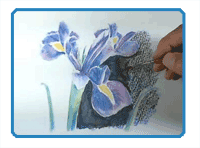
By Matt Fussell
Watercolor pencils basically consist of dry watercolor medium held together in pencil form. The material has been altered to a degree to allow for the material to be easily spread over the surface producing marks that are similar to colored pencils. When water is added to the surface, the material activates, producing instant watercolor effects.
Because of these unique characteristics, watercolor pencils enjoy the versatility of two different art techniques, painting and drawing. Marks can be made using the control of the pencil and then when water is added, a brush can be used to make graceful marks and transitions of value and tone. Watercolor pencils can be used in reverse order as well. Adding the pencils to areas that already have water applied can produce interesting marks as well.
Typically, watercolor pencils are applied to watercolor papers, but other surfaces that can accept washes of water are also suitable. Clayboard or illustration board are good choices as surfaces for watercolor pencils.
Watercolor pencils can also be mixed with other media as well. Soft pastels, colored pencils and pen and ink mix well with watercolor pencils. These mediums can be used to enhance contrast, push values, or to intensify areas of a work.
The watercolor can be worked around on the surface using a brush once the medium is activated with water. While a variety of brushes are suitable for this, I have found that nylon brushes seem to respond best with the medium.
Beginning artists that are comfortable with drawing but not sure about venturing into painting, should give watercolor pencils a shot. It is a great transition medium. One issue that many have when starting with watercolor is making the paint too transparent. The nature of the medium forces the intensity of the color virtually eliminating this beginner mistake.
In the demonstration in the video that follows, I am using a watercolor pencils to complete a drawing/painting of an iris...
Here are some more art lessons that you may like...